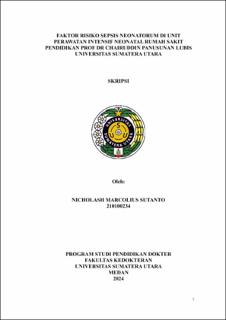Faktor Risiko Sepsis Neonatorum di Unit Perawatan Intensif Neonatal Rumah Sakit Pendidikan Prof Dr Chairuddin Panusunan Lubis Universitas Sumatera Utara
Risk Factors of Neonatal Sepsis in the Neonatal Intensive Care Unit at Prof Dr Chairuddin Panusunan Lubis Teaching Hospital Universitas Sumatera Utara

Date
2024Author
Sutanto, Nicholash Marcolius
Advisor(s)
Wahyuni, Fera
Metadata
Show full item recordAbstract
Background. Neonatal mortality remains a significant issue in developing countries such as Indonesia. One of the major causes of high morbidity and mortality rates is neonatal sepsis. Objective. This study aims to determine the incidence, characteristics, and risk factors of neonatal sepsis among newborns treated in the Neonatal Intensive Care Unit (NICU) of Prof. Dr. Chairuddin Panusunan Lubis Teaching Hospital, Universitas Sumatera Utara (RSP CPL USU). Methods. A retrospective study was conducted, and data were collected from the medical records of 80 newborns admitted to the NICU of RSP CPL USU from January 2023 to July 2024 using consecutive sampling. Bivariate and multivariate analyses were performed using logistic regression tests with a statistical significance level of 0.05. Results. The incidence of neonatal sepsis in the NICU of RSP CPL USU was 54 out of 117 newborns (62.07%). Risk factors for neonatal sepsis included gestational age (COR = 3.21; 95% CI = 1.20–8.54), birth weight (COR = 2.96; 95% CI = 1.12–7.80), use of mechanical ventilation (COR = 4.51; 95% CI = 1.20–16.94), prolonged parenteral nutrition (COR = 15.90; 95% CI = 2.00–126.36), and maternal infection during pregnancy (COR = 2.94; 95% CI = 1.12–7.75), all of which were significantly associated with neonatal sepsis. The most dominant risk factor was prolonged parenteral nutrition (AOR = 11.92; 95% CI = 1.39–102.02). Conclusion. Prolonged parenteral nutrition is the most significant risk factor for neonatal sepsis.
Collections
- Undergraduate Theses [2272]
